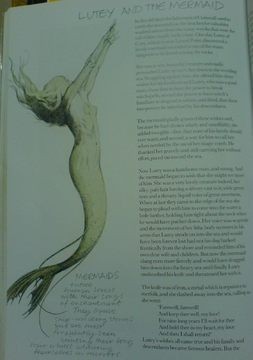
哥本哈根--青銅人魚像(在我之前文章"水中綠世界"貼過.世界知名景點.)
Mermaids are one of the most famous creatures of popular culture, and are depicted regularly in literature and film. This is likely due to the influence of Hans Christian Andersen's fairytale The Little Mermaid (1836), which has been translated into many languages and adapted into various mediums. Andersen's portrayal has arguably become the standard, and has influenced most modern Western depictions of mermaids since it was published.
安徒生童話中的人魚
迪士尼的人魚Ariel
Andersen's Little Mermaid was immortalized with a famous bronze sculpture in Copenhagen harbour, and was adapted into a Disney movie (The Little Mermaid, 1989). The story has been retold in other films and television programs, and regularly features in collections of fairytales.
希羅神話中簡單版本
7000 years ago in Babylonian mythology, there was a god, Ea (who later would be called Oannes by the Greeks), who was a water god. he was depicted as having the upper body of a man, and the lower body of a fish. From the beginning of civilization as we know it, there have been merfolk.
希臘羅馬神話複雜版本1
Tales of mermaids are nearly universal. The first known mermaid stories appeared in Assyria, ca. 1000 BCE. Atargatis, the mother of Assyrian queen Semiramis, was a goddess who loved a mortal shepherd and in the process killed him. Ashamed, she jumped into a lake to take the form of a fish, but the waters would not conceal her divine nature. Thereafter, she took the form of a mermaid — human above the waist, fish below — though the earliest representations of Atargatis showed her as being a fish with a human head and legs, similar to the Babylonian Ea. The Greeks recognized Atargatis under the name Derketo, where she was often conflated with Aphrodite.
Lucian of Samosata in Syria (2nd century CE) in De Dea Syria ("Concerning the Syrian Goddess") wrote of the Syrian temples he had visited:
"Among them - Now that is the traditional story among them concerning the temple. But other men swear that Semiramis of Babylonia, whose deeds are many in Asia, also founded this site, and not for Hera Atargatis but for her own Mother, whose name was Derketo"
"I saw the likeness of Derketo in Phoenicia, a strange marvel. It is woman for half its length, but the other half, from thighs to feet, stretched out in a fish's tail. But the image in the Holy City is entirely a woman, and the grounds for their account are not very clear. They consider fishes to be sacred, and they never eat them; and though they eat all other fowls, they do not eat the dove, for she is holy so they believe. And these things are done, they believe, because of Derketo and Semiramis, the first because Derketo has the shape of a fish, and the other because ultimately Semiramis turned into a dove. Well, I may grant that the temple was a work of Semiramis perhaps; but that it belongs to Derketo I do not believe in any way. For among the Egyptians, some people do not eat fish, and that is not done to honor Derketo."
希臘加勒比海神話.複雜版本2
(我最喜歡的..牽涉到蛇髮女.水手.航海..陶藝作品跟此傳說相關..)
A popular Greek legend has Alexander the Great's sister, Thessalonike, turn into a mermaid after her death. She lived, it was said, in the Aegean and when sailors would encountered her, she would ask them only one question: "Is Alexander the king alive?" (Greek: Ζει ο βασιλιάς Αλέξανδρος), to which the correct answer would be "He lives and still rules" (Greek: Ζει και βασιλεύει). Any other answer would spur her into a rage, where she transformed into a Gorgon and mean doom for the ship and every sailor onboard.
Among the Neo-Taíno nations of the Caribbean the mermaid is called Aycayíashe of the beautiful voice. Her attributes relate to the goddess Jagua, and the hibiscus flower of the majagua tree Hibiscus tiliaceous. Examples from other cultures are the Mami Wata of West Africa, the Jengu of Cameroon, the Merrow of Ireland and Scotland, the Rusulki of Russia, and the Greek Oceanids, Nereids, and Naiads. One freshwater mermaid-like creature from European folklore is Melusine, who is sometimes depicted with two fish tails, and other times with the lower body of a serpent. It is said in Japan that eating the flesh of a mermaid can grant unaging immortality. In some European legends mermaids are said to grant wishes.
生物學解釋1
It has been widely suggested that manatees could be behind the myth of the mermaid. These large aquatic mammals are notable for the way in which they carry their young, cradled in their arms much as a human would carry a baby. It is possible that sailors seeing these unfamiliar beasts for the first time, would assume that they had in fact stumbled across some sort of humanoid species, and consequently spread their accounts of the sightings through their homelands on their return from voyages. It has even been posited that the traditional image of a mermaid with long flowing hair could be attributed to manatees breaking the ocean surface underneath patches of seaweed, and giving the unfamiliar observer the impression of having long hair.
生物學解釋2
There is however a second explanation. "The aquatic ape theory or aquatic ape hypothesis (AAT/AAH) is a hypothesis in evolutionary biology proposing that the ancestors of human ancestors went through one or more periods of time living in a semi-aquatic setting and that this accounts for many of the characteristics of species in the Homo genus that are not seen in other primates, such as chimpanzees or gorillas."
"Most orthodox paleoanthropologists adhere to the Savanna Theory, which holds that human ancestors evolved in hot and dry savanna environments. The AAT says that human ancestors evolved in warm and wet environments and went through one or more periods of time living in a waterside setting, gathering much of their foods from shallow sea-, lake- or riverside environments through beach-combing, wading and diving, for instance, coconuts, bird's eggs, turtles, shell- and crayfish, part of reeds, papyrus and other aquatic plants. There are interpretations which propose fresh-water habitats, variations in the timescale and the proposed degree of selection arising from moving through water. One interpretation is that the semi-aquatic episode coincided with the Pliocene-Pleistocene littoral diaspora of Homo along the East-African Rift valley lakes and the African and Indian Ocean coasts.
Prior to 546 B.C., the Milesian philosopher Anaximander proposed that mankind had sprung from an aquatic species of animal. For, he thought, man with his extended infancy could not have survived, originally, in the manner he does presently. This idea, based on elemental forces of mutation as opposed to evolution, does not appear to have survived Anaximander's death.
That said, it may be possible to imagine a sub-species of humanoid which was water-based and which may have contributed, at least in part, to the existence of the subject of mermaids.
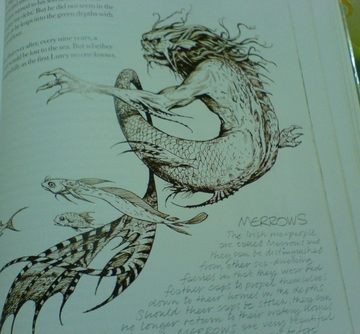
mermaid..
A mermaid (from mere in the obsolete sense 'sea' + maid(en)) is a legendary aquatic creature with the head and torso of human female and the tail of a fish. Various cultures throughout the world have similar figures. They were known to sing sailors to their deaths, like the Siren, or squeeze the life out of drowning men, while trying to rescue them.
The Sirens of Greek mythology are sometimes portrayed in later folklore ; in fact in some languages the name sirena is used interchangeably for both creatures. Other related types of mythical or legendary creature are water fairies (e.g. various water nymphs) and selkies.
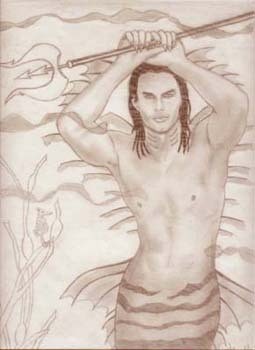
merrow
Merrow (from Gaelic murúch) or Murrough (Galloway) is the Scottish and Irish Gaelic equivalent of the mermaid and mermen of other cultures. These beings are said to appear as human from the waist up but have the body of a fish from the waist down. They have a gentle, modest, affectionate and benevolent disposition.
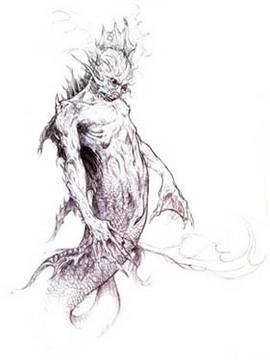
merman
Triton is a Greek god, the messenger of the deep. He is the son of Poseidon, god of the sea, and Amphitrite, goddess of the sea. He is usually represented as a merman, having the upper body of a human and the tail of a fish.
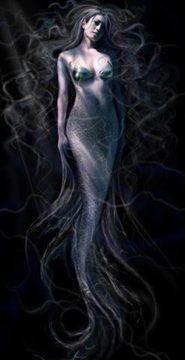
merfolk
A mermaid as known from many legends throughout Santharia. It is said that the Merfolk are located along most coastal shores of Santharia, but are most commonly found in the strait between the R'unorian Isles and the mainland. They prefer resting and preening in the shallower warm waters but often venture out into the deeps to hunt and play. They are sentient creatures, although not high in intelligence.
1.其他人魚美圖分享
(我電腦裡光是人魚的圖片佔了不少空間..貼都貼不完..)
2.人魚存在的證據..(塑型)標本..有些公開...有些私藏..日本..美國
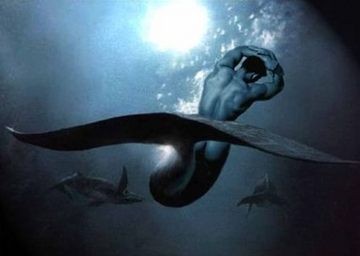
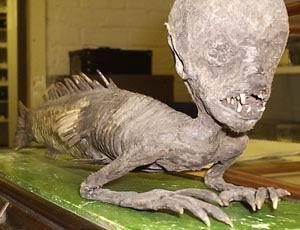
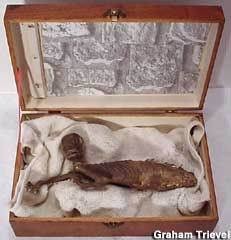
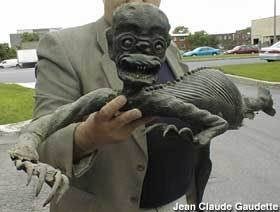
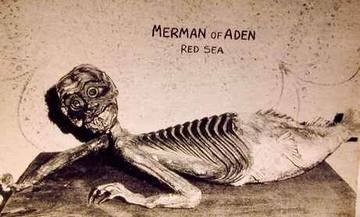
全站熱搜


 留言列表
留言列表